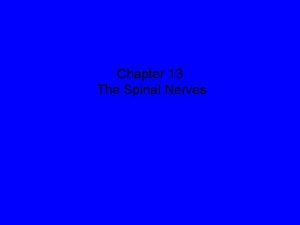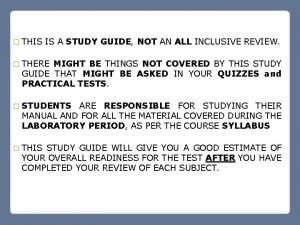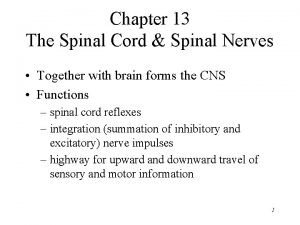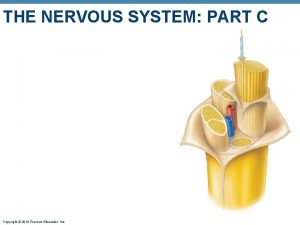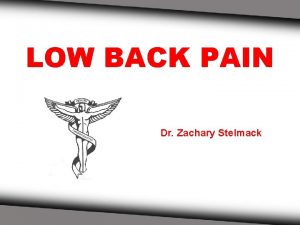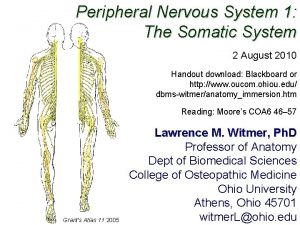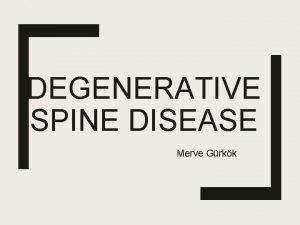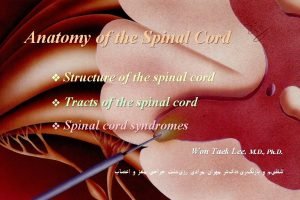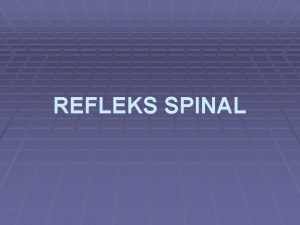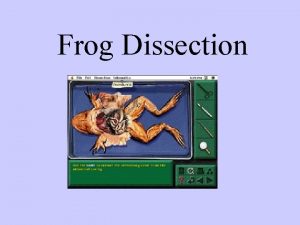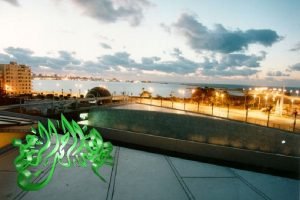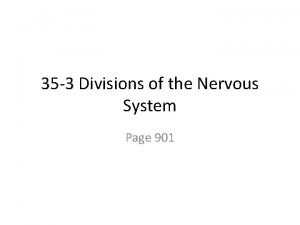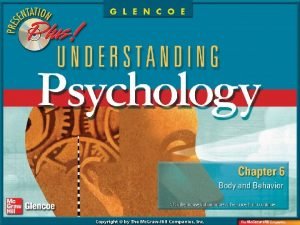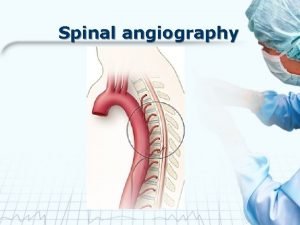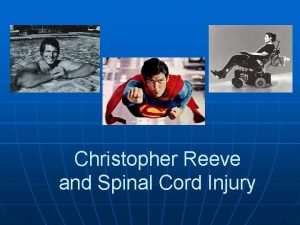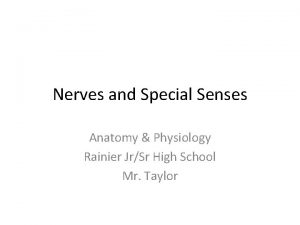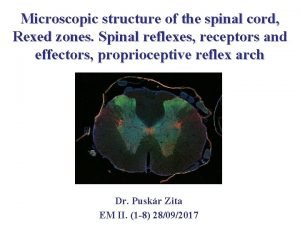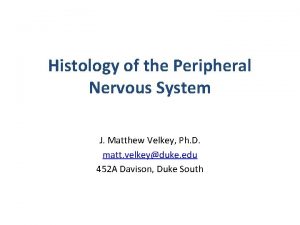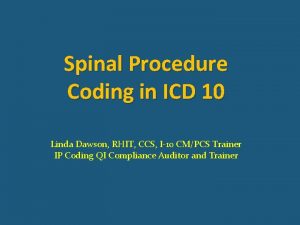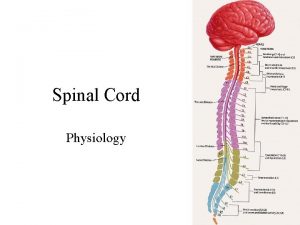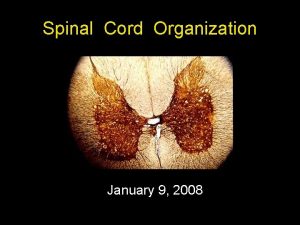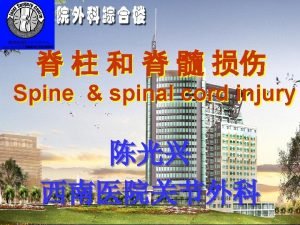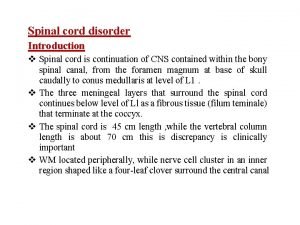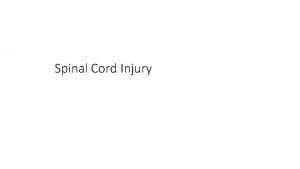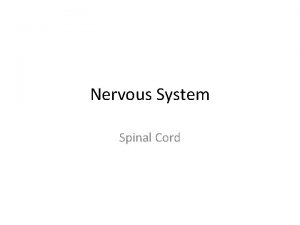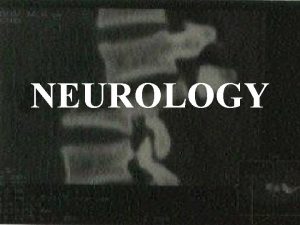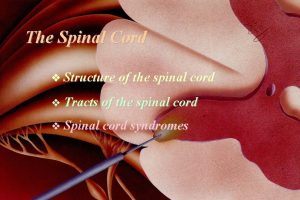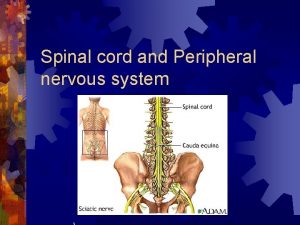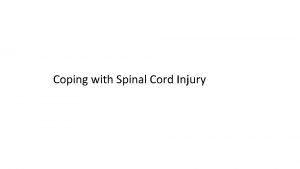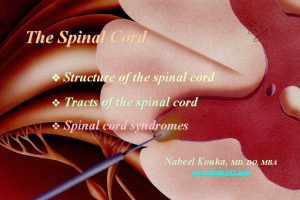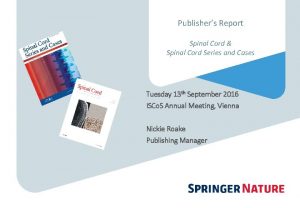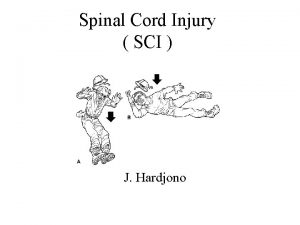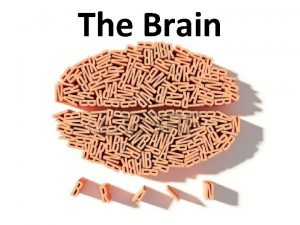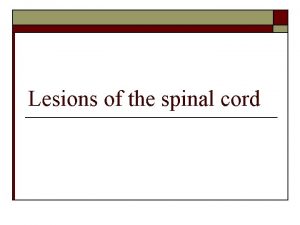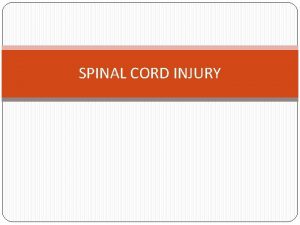I Anatomy II Physiology Spinal Cord 1 The

































- Slides: 33

I. Anatomy II. Physiology Spinal Cord 1

The Spinal Cord & Spinal Nerves § Together with brain forms the CNS § Functions 1. spinal cord reflexes 2. integration (summation of inhibitory and excitatory) nerve impulses 3. highway for upward and downward travel of sensory and motor information 2

I. Anatomy 1. Protective Structures 2. External 3. Internal 4. Spinal Nerves a. Covering b. Distribution c. Dermatomes II. Physiology Spinal Cord 3

Spinal Cord Protection 1. vertebral column 4

Structures Covering the Spinal Cord 2. Membrane A. Dura mater - dense irregular CT tube § Subdural space filled with interstitial fluid B. Arachnoid = spider web of collagen fibers A. Subarachnoid space = CSF C. Pia mater § thin layer covers BV § denticulate ligs hold in place 5

External Anatomy of Spinal Cord § Flattened cylinder § 16 -18 Inches long & 3/4 inch diameter § In adult ends at L 2 § In newborn ends at L 4 § Growth of cord stops at age 5 1. Cervical enlargement § 2. upper limbs Lumbar enlargement § lower limbs 6

Inferior End of Spinal Cord 1. Conus medullaris § 2. 3. cone-shaped end of spinal cord Filum terminale § thread-like extension of pia mater § stabilizes spinal cord in canal Caudae equinae (horse’s tail) § 4. Conus medullaris dorsal & ventral roots of lowest spinal nerves Spinal segment § area of cord from which each pair of spinal nerves arises Filum terminale 7

Spinal Cord & Spinal Nerves § Spinal nerves begin as roots Posterior Root (Sensory) 1. Dorsal or posterior root is incoming sensory fibers § dorsal root ganglion (swelling) = cell bodies of sensory nerves 2. Ventral or anterior root is outgoing motor fibers Anterior Root (Motor) 8

Gray Matter of the Spinal Cord § Central canal continuous with 4 th ventricle of brain § Gray matter is shaped like the letter H or a butterfly § contains neuron cell bodies, unmyelinated axons & dendrites § paired dorsal and ventral gray horns § lateral horns only present in thoracic spinal cord § gray commissure crosses the midline 10

White Matter of the Spinal Cord § White matter covers gray matter § Anterior median fissure deeper than Posterior median sulcus § Anterior, Lateral and Posterior White Columns contain axons that form ascending & descending tracts 11

Spinal Nerves § 31 Pairs of spinal nerves § Named & numbered by the cord level of their origin 1. 8 pairs of cervical nerves (C 1 to C 8) 2. 12 pairs of thoracic nerves (T 1 to T 12) 3. 5 pairs of lumbar nerves (L 1 to L 5) 4. 5 pairs of sacral nerves (S 1 to S 5) 5. 1 pair of coccygeal nerves § Mixed sensory & motor nerves 12

A Nerve Plexus § Joining of ventral rami of spinal nerves to form nerve networks or plexuses § Found in neck, arm, low back & sacral regions § No plexus in thoracic region § intercostal nn. innervate intercostal spaces § T 7 to T 12 supply abdominal wall as well 16

Cervical Plexus § Ventral rami of spinal nerves (C 1 to C 5) § Supplies parts of head, neck & shoulders § Phrenic nerve (C 3 -C 5) keeps diaphragm alive § Damage to cord above C 3 causes respiratory arrest 17

Phrenic Nerve 18

Brachial Plexus § Ventral rami from C 5 to T 1 § Supplies shoulder & upper limb § Passes superior to 1 st rib & under clavicle § Axillary n. = deltoid & teres m. § Musculocutaneous n. = elbow flexors § Radial n. = shoulder & elbow extensors § Median & ulnar nn. = flexors of wrist & hand 19

Branches off Brachial Plexus 20

Lumbar Plexus § Ventral rami of L 1 to L 4 § Supplies abdominal wall, external genitals & anterior/medial thigh § Injury to femoral nerve causes inability to extend leg & loss of sensation in thigh § Injury to obturator nerve causes paralysis of thigh adductors 22

Branches of Lumbar Plexus § Notice: Femoral and Obturator nerves § Found anterior and medial to hip joint 23

Sacral Plexus § Ventral rami of L 4 -L 5 & S 1 -S 4 § Anterior to the sacrum § Supplies buttocks, perineum & part of lower limb § Sciatic nerve = L 4 to S 3 supplies post thigh & all below knee § Peroneal nerve injury produces foot drop or numbness § Tibial nerve injury produces calcaneovalgus (loss of function on anterior leg & dorsum of foot) 24

Branches of Sacral Plexus 25

Sciatic Nerve Branches § Notice: Common Peroneal nerve and Tibial nerve behind the knee § Notice: Sciatica pain extends from the buttock down the leg to the foot § may be sign of herniated disc 26

Dermatomes & Myotomes § Each spinal nerve contains both sensory & motor nerve fibers § Dermatome § area of skin supplied by one spinal nerve § overlap prevents loss of sensation if one damaged § sensory anesthesia requires 3 spinal nerves to be blocked § Skin on face supplied by Cranial Nerve V 27

I. Anatomy II. Physiology 1. Tracts 2. Reflexes a. Stretch b. Tendon c. Flexor d. Crossed Extensor Spinal Cord 29

Tracts of the Spinal Cord § Function of tracts 1. highway for sensory & motor information 2. sensory tracts ascend 3. motor tracts descend § Naming of tracts § indicates position & direction of signal § example = anterior spinothalamic tract § impulses travel from spinal cord towards brain (thalamus) § found in anterior part of spinal cord 30

Location of Tracts inside Cord Motor tracts Sensory tracts pyramidal tract (corticospinal) spinothalamic tract extrapyramidal tract posterior column spinocerebellar 31

Function of Spinal Tracts two-point discrimination, pressure and vibration pain, temperature, deep pressure 32

Function of Spinal Tracts voluntary movements, posture & muscle tone, equilibrium 33

Spinal Reflexes § Automatic response to change in environment § Integration center for spinal reflexes is gray matter of spinal cord § Examples § somatic reflexes result in skeletal muscle contraction § autonomic (visceral) reflexes involve smooth & cardiac muscle and glands. § heart rate, respiration, digestion, urination, etc § Note: cranial reflexes involve cranial nerves 34

Reflex Arc § Specific nerve impulse pathway § 5 components of reflex arc § 1. receptor 2. sensory neuron 3. integrating center 4. motor neuron 5. effector 4 important somatic spinal reflexes 1. stretch, 2. tendon, 3. flexor(withdrawal) 4. crossed extensor reflexes 35

Illustration of the Stretch Reflex 37

Illustration of Tendon Reflex 40

Flexor (withdrawal) Reflex § Step on tack (pain fibers send signal to spinal cord) § Interneurons branch to different spinal cord segments § Motor fibers in several segments are activated § More than one muscle group activated to lift foot off of tack 41

Crossed Extensor Reflex § Lifting left foot requires extension of right leg to maintain one’s balance § Pain signals cross to opposite spinal cord § Contralateral extensor muscles are stimulated by interneurons to hold up the body weight § Reciprocal innervation when extensors contract flexors relax, etc 42
 Lateral pectoral nerve
Lateral pectoral nerve Spinal cord and spinal nerves exercise 15
Spinal cord and spinal nerves exercise 15 Exercise 15 spinal cord and spinal nerves
Exercise 15 spinal cord and spinal nerves Figure 13-2 spinal nerves
Figure 13-2 spinal nerves Lumbosacral enlargement
Lumbosacral enlargement Spinal cord nerve anatomy
Spinal cord nerve anatomy The tapered conical portion of the spinal cord is the
The tapered conical portion of the spinal cord is the Gray commissure
Gray commissure 31 pairs of spinal nerves
31 pairs of spinal nerves Spinal cord anatomy
Spinal cord anatomy Low back rom
Low back rom Somatic nervous system
Somatic nervous system Scottie dog lumbar spine
Scottie dog lumbar spine Spinal cord
Spinal cord Spinal cord injury shoulder exercises
Spinal cord injury shoulder exercises Spinal cord
Spinal cord Eat well live well with spinal cord injury
Eat well live well with spinal cord injury Supraspinal adalah
Supraspinal adalah Spinal cord organization
Spinal cord organization T10 spinal cord
T10 spinal cord Spinal cord injury rehabilitation st. louis
Spinal cord injury rehabilitation st. louis Frog spleen
Frog spleen Spinal cord anterior
Spinal cord anterior Hyporeflexia and hyperreflexia
Hyporeflexia and hyperreflexia Spinal cord and brain
Spinal cord and brain Nerves branching beyond the spinal cord into the body
Nerves branching beyond the spinal cord into the body Spinal angiogram anatomy
Spinal angiogram anatomy Christopher reeve spinal cord injury level
Christopher reeve spinal cord injury level Spinal cord
Spinal cord Spinal cord structure
Spinal cord structure Mechanoreceptor
Mechanoreceptor Stretch reflex
Stretch reflex Coding procedure
Coding procedure Nice spinal cord compression
Nice spinal cord compression





